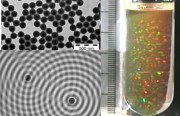Digital Videomicroscopy (dvm)
When using scattering methods (DLS, FRS), information about dynamic processes can only be obtained indirectly. However, if the length scale of the examined object is in the range of the wavelength of visual light and if a suitable contrast is achievable, microscopic techniques can be applied. In our experiments we use dark field microscopy. In this technique the direct beam is blocked and the sample is illuminated indirectly, thus only light scattered by particles reaches the objective. So it is of general importance to have a large contrast between particle and solvent. This method shows a negative picture of the sample (white particles in front of a black background).Digital Videomicroscopy (DVM):
Advantages of this method:
- Even small particles can be investigated in the microscope if the contrast is
strong enough.
- Using tracer methods one- and multiparticle dynamics can be investigated.
- Direct visualization of the trajectories of single particles.
Trajectories for different volume fractions
Combined with video technology and digital imaging the dynamic behavior of colloidal particles can be investigated. For example the decrease of the diffusion coefficient with increasing particle concentration can be directly visualized. Using computer programs to control the video recorder and to evaluate the recorded frames the investigation of hundred of frames is possible. A time delay of 20 ms between 2 frames can be achieved.

